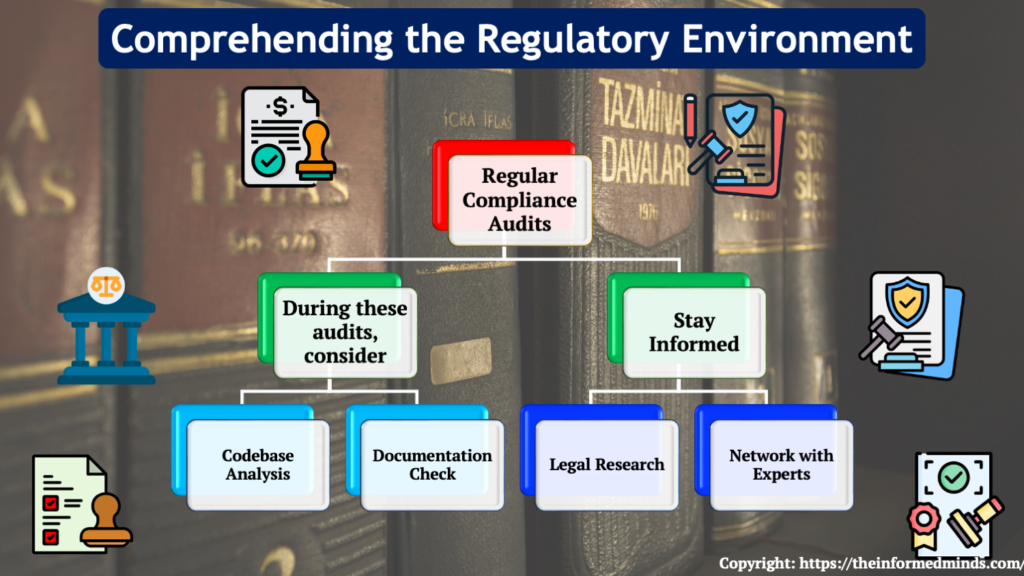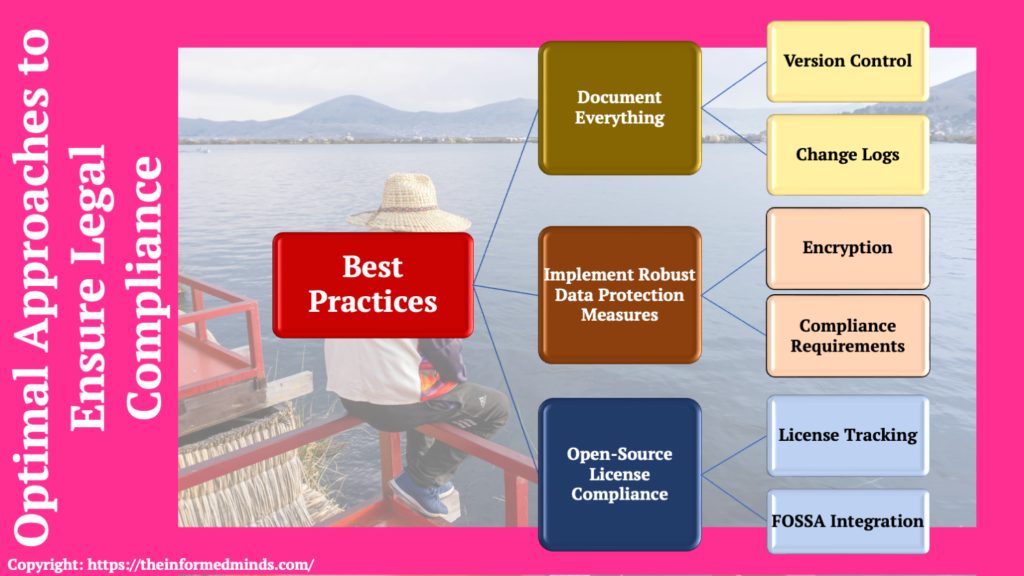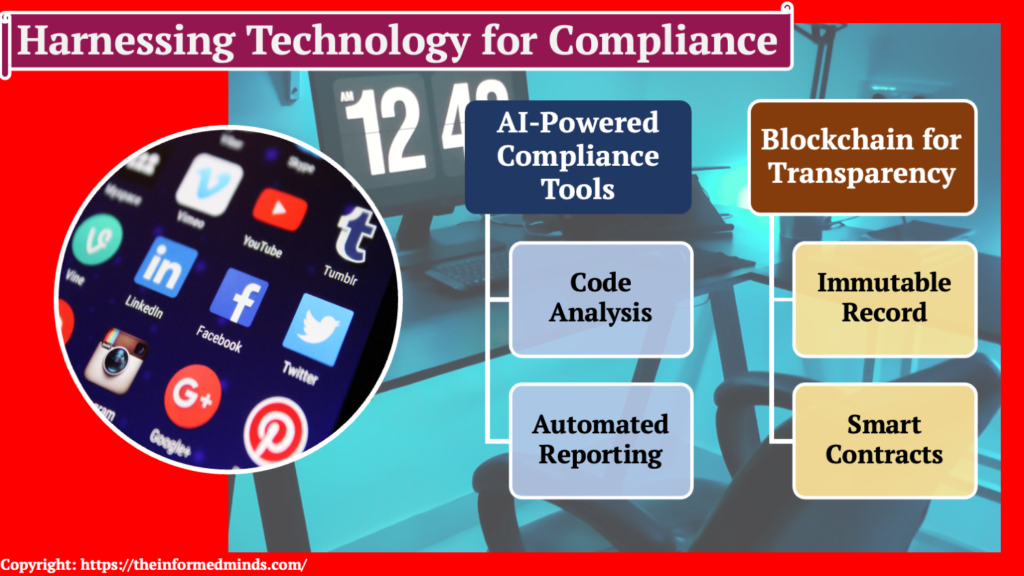To Share is to Show You Care!
Welcome to the ever-evolving landscape of software development! As technology advances, so do the legal and regulatory challenges that developers face. In this blog post, we’ll explore how to navigate the software legal minefields of 2023, unveiling the best solutions for achieving regulatory compliance. Buckle up as we embark on a journey to unlock success without the looming specter of legal headaches.
1. Understanding the Regulatory Landscape
Regular compliance audits involve systematic reviews of your software development processes and practices to ensure they align with the latest legal requirements. Conducting these audits at regular intervals, such as quarterly or annually, helps identify and address potential compliance issues before they escalate.

1.1 During these audits, consider
Regular compliance audits involve systematic reviews of your software development processes and practices to ensure they align with the latest legal requirements. Conducting these audits at regular intervals, such as quarterly or annually, helps identify and address potential compliance issues before they escalate.
1.1.1 Codebase Analysis
Review your codebase for compliance with industry standards and legal regulations
1.1.2 Documentation Check
Verify that your documentation accurately reflects the current state of your software and its compliance with regulations.
1.2 Stay Informed
Staying informed about changes in regulations is critical for proactive compliance. Subscribe to industry newsletters, legal updates, and participate in relevant forums to keep abreast of regulatory developments. This can involve.
1.2.1 Legal Research
Regularly conduct legal research to identify any new laws, standards, or precedents that may impact your software.
1.2.2 Network with Experts
Build a network of legal experts and professionals who specialize in software compliance to gain insights into evolving regulatory landscapes.
2. Best Practices for Legal Compliance

2.1 Document Everything
2.1.1 Version Control
Version control is a systematic way of tracking changes made to your software’s source code over time. It involves using tools like Git or SVN to create a historical record of alterations, additions, or deletions in the codebase. Here’s why version control is crucial for legal compliance
2.1.1.1 Audit Trail
Version control systems provide an audit trail, allowing you to trace every change made to the code and understand who made the changes.
2.1.1.2 Reproducibility
Having a versioned codebase ensures that you can reproduce any previous version of your software, which can be crucial for legal investigations or audits.
2.1.2 Change Logs
Change logs are detailed records that document modifications made to your software. They typically include information such as the date of the change, the person responsible, and a brief description of the change. The significance of maintaining comprehensive change logs includes
2.1.2.1 Transparency
Change logs enhance transparency by providing a clear overview of how your software evolves over time.
2.1.2.2 Issue Tracking
They aid in issue tracking and resolution by providing context to changes, making it easier to identify the source of problems or errors.
2.2 Implement Robust Data Protection Measures
2.2.1 Encryption
Encryption involves converting data into a coded form to prevent unauthorized access. Implementing robust encryption measures is crucial for protecting sensitive information. Here’s why,
2.2.1.1 Data Security
Encryption ensures that even if unauthorized individuals gain access to your data, they cannot decipher its meaning without the appropriate encryption keys.
2.2.2 Compliance Requirements
Many data protection regulations mandate the use of encryption to safeguard sensitive data, making it a legal necessity in certain contexts.
2.2.2.1 Access Controls
Access controls refer to the mechanisms in place that limit access to certain resources or information. Robust access controls are essential for legal compliance due to
2.2.2.2 Privacy Compliance
Access controls help ensure that only authorized personnel have access to sensitive data, aligning with privacy regulations.
2.2.2.3 Data Integrity
By restricting access, you enhance data integrity by preventing unauthorized individuals from making unauthorized changes.
2.3 Open-Source License Compliance
2.3.1 License tracking
License tracking involves maintaining a comprehensive inventory of all open-source components used in your software and understanding the terms of their respective licenses. Here’s why this is crucial for legal compliance:
2.3.1.1 Avoiding Violations
Tracking licenses helps you avoid unintentional violations by ensuring that you adhere to the conditions specified in each open-source license.
2.3.1.2 Risk Mitigation
Understanding the licenses of your dependencies allows you to assess potential legal risks associated with using particular open-source components.
2.3.2 FOSSA Integration
FOSSA is a tool that automates the tracking of open-source licenses and helps identify potential compliance issues. Integrating FOSSA into your development process provides several benefits:
2.3.2.1 Automated Compliance Checks
FOSSA automatically scans your codebase, identifying open-source components and checking them against a comprehensive database of licenses.
2.3.2.2 Continuous Monitoring
By integrating FOSSA into your continuous integration/continuous deployment (CI/CD) pipeline, you can ensure that compliance is continuously monitored as your software evolves.
3. Leveraging Technology for Compliance

3.1 AI-Powered Compliance Tools
Artificial intelligence can be a powerful ally in identifying and addressing potential legal issues in your codebase. This involves,
3.1.1 Code Analysis
Use AI tools to analyze your code for potential compliance issues, such as license violations or security vulnerabilities.
3.1.2 Automated Reporting
Implement automated reporting to receive real-time insights into the compliance status of your software.
3.2 Blockchain for Transparency
Implementing blockchain technology enhances transparency in your software development process. This can be achieved through:
3.2.1 Immutable Record
Utilize blockchain to create an immutable and transparent record of your development process.
3.2.2 Smart Contracts
Implement smart contracts to automate certain compliance-related processes, ensuring adherence to predefined rules.
4. Embracing a Proactive Compliance Culture

4.1 Training and Awareness Programs
Educating your development team on legal requirements and best practices is essential. This involves:
4.1.1 Regular Workshops
Conduct workshops and training sessions to keep your team updated on the latest legal developments.
4.1.2 Documentation Guidelines
Provide guidelines on how to document code changes and development processes to ensure compliance.
4.2 Cross-Functional Collaboration
Foster collaboration between legal, development, and compliance teams to create a holistic approach to compliance. This includes:
4.2.1 Regular Meetings
Schedule regular meetings between legal and development teams to discuss ongoing projects and potential compliance issues.
4.2.2 Integrated Workflows
Implement integrated workflows that involve collaboration between legal and development teams at key stages of the software development life cycle.
Conclusion
In conclusion, successfully navigating software legal minefields in 2023 requires a multifaceted approach. By understanding the regulatory landscape, adopting best practices, leveraging technology, and fostering a proactive compliance culture, you can position your software development endeavors for success. Compliance isn’t just a regulatory burden—it’s a strategic advantage in the competitive world of software development. Here’s to a compliant and successful 2023! 🚀
Frequently Asked Questions
Q1: What is regulatory compliance in software?
A: Regulatory compliance in software refers to the adherence of software development and deployment processes to the laws, standards, and regulations applicable to the industry. It involves ensuring that software activities meet legal requirements, industry standards, and any relevant guidelines set forth by regulatory bodies.
Q2: What are legal compliance issues?
A: Legal compliance issues in the context of software pertain to situations where software development, distribution, or usage violates applicable laws and regulations. These issues can range from intellectual property infringement and data privacy violations to non-compliance with licensing agreements and industry-specific regulations.
Q3: What are the two ways that regulatory compliance issues?
A: Regulatory compliance issues can arise in two main ways: through failures in adhering to existing regulations, leading to non-compliance, and through challenges in adapting to new or updated regulations that impact the software industry.
Q4: What is complying with legal and regulatory requirements?
A: Complying with legal and regulatory requirements involves ensuring that software development, deployment, and usage align with the laws and regulations relevant to the industry. This encompasses adherence to data protection laws, licensing agreements, intellectual property rights, and any other legal frameworks that govern software activities.
Q5: What is regulatory compliance in cybersecurity?
A: Regulatory compliance in cybersecurity involves aligning the practices, processes, and technologies related to information security with the regulations and standards in the cybersecurity domain. This includes compliance with laws such as GDPR, HIPAA, or industry-specific cybersecurity frameworks.
Q6: What is the difference between regulatory compliance and policy compliance?
A: Regulatory compliance focuses on adhering to external laws and regulations, while policy compliance centers around internal policies and guidelines set by an organization. While regulatory compliance is often mandatory and enforced by external entities, policy compliance is driven by an organization’s internal rules and standards.
Q7: What are the four key compliance issues?
A: Four key compliance issues include data privacy and protection, intellectual property rights, adherence to licensing agreements, and compliance with industry-specific regulations. Addressing these issues is crucial for maintaining legal and regulatory compliance in the software industry.
Q8: What is the most common compliance issue?
A: One of the most common compliance issues is related to data privacy and protection. With the increasing focus on user privacy, failure to comply with data protection laws can lead to severe legal consequences and damage to an organization’s reputation.
Q9: What is an example of a compliance issue?
A: An example of a compliance issue is the unauthorized use of open-source software in a proprietary project without adhering to the terms of the open-source license. This can result in legal ramifications and reputational damage for the organization.
Q10: How can I improve my regulatory compliance?
A: To improve regulatory compliance, organizations can conduct regular compliance audits, stay informed about changes in regulations, implement robust documentation practices, leverage compliance tools and technologies, and foster a culture of awareness and adherence to compliance standards among employees.
Q11: What are regulatory issues?
A: Regulatory issues encompass challenges and complexities related to compliance with laws, regulations, and standards in a particular industry. These issues can arise from changes in regulations, the need for continuous monitoring, and ensuring that business practices align with evolving legal requirements.
Q12: How do you manage regulatory compliance?
A: Managing regulatory compliance involves establishing clear policies and procedures, conducting regular risk assessments, implementing monitoring and reporting mechanisms, staying updated on regulatory changes, and fostering a collaborative approach across relevant departments to ensure ongoing adherence to regulatory requirements.
Q13: What is legal and compliance?
A: Legal and compliance collectively refer to activities and processes within an organization that ensure adherence to both external laws and internal policies. Legal compliance involves meeting external legal requirements, while compliance, in a broader sense, includes adherence to internal guidelines and industry best practices.
Q14: What is a regulatory compliance checklist?
A: A regulatory compliance checklist is a document that outlines the specific requirements, laws, and standards that an organization must adhere to in a particular industry. It serves as a tool for organizations to systematically assess and ensure compliance with relevant regulations.
Q15: What’s the difference between legal and compliance?
A: The main difference between legal and compliance is that legal refers to external laws and regulations that organizations must follow, while compliance encompasses the broader spectrum of adhering to both external laws and internal policies and procedures set by the organization itself.
The Informed Minds
I'm Vijay Kumar, a consultant with 20+ years of experience specializing in Home, Lifestyle, and Technology. From DIY and Home Improvement to Interior Design and Personal Finance, I've worked with diverse clients, offering tailored solutions to their needs. Through this blog, I share my expertise, providing valuable insights and practical advice for free. Together, let's make our homes better and embrace the latest in lifestyle and technology for a brighter future.

